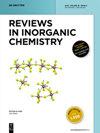Variable heterotridentate ligands in Pt(ƞ3-X1C1X2)(PL) (X1,2 = N or S), Pt(ƞ3-X1N1Y1)(PL) (X, Y = O, C; C, S; or O, S) and Pt(ƞ3-S1B1S2)(PL), derivatives – structural aspects
IF 3.1
3区 化学
Q1 CHEMISTRY, INORGANIC & NUCLEAR
引用次数: 0
Abstract
This review covers 17 Pt(II) complexes of the compositions: Pt(ƞ铂(ƞ3-X1C1X2)(PL)(X1,2 = N 或 S)、铂(ƞ3-X1N1Y1)(PL)(X, Y = O, C; C, S; 或 O, S)和铂(ƞ3-S1B1S2)(PL)中的可变异戟配体,衍生物 - 结构方面的问题
本综述涉及 17 种铂(II)络合物的组成:Pt(ƞ3-N1C1N2)(PL)、Pt(ƞ3-S1C1S2)(PL)、Pt(ƞ3-S1B1S2)(PL)、Pt(ƞ3-S1S2O1)(PL)、Pt(ƞ3-O1N1C1)(PL)、Pt(ƞ3-O1N1S1)(PL) 和 Pt(ƞ3-C1N1S1)(PL)。这些配合物以三种晶体类别结晶:单斜(8 例)、三斜(8 例)和正交(1 例)。杂三齿配体形成了 5 + 5 元金属环(最常见)和 5 + 6 元金属环。带有单齿 P 配体的杂三叉配体会围绕铂(II)原子形成扭曲的方形平面几何。分析了 Pt-L 和 L-Pt-L。表示畸变程度的 τ 4 参数在句子中不断增加:0.057 Pt(ƞ3-O1N1S1)(PL) < 0.066 Pt(ƞ3-S1C1S2)(PL) < 0.149 Pt(ƞ3-S1S2O1)(PL) < 0.158 Pt(ƞ3-O1N1C1)(PL) < 0.160 Pt(ƞ3-C1N1S1)(PL) < 0.162 Pt(ƞ3-S1B1S2)(PL) < 0.165 Pt(ƞ3-N1C1N2)(PL).
本文章由计算机程序翻译,如有差异,请以英文原文为准。
求助全文
约1分钟内获得全文
求助全文
来源期刊

Reviews in Inorganic Chemistry
化学-分析化学
CiteScore
7.30
自引率
4.90%
发文量
20
审稿时长
1 months
期刊介绍:
Reviews in Inorganic Chemistry (REVIC) is a quarterly, peer-reviewed journal that focuses on developments in inorganic chemistry. Technical reviews offer detailed synthesis protocols, reviews of methodology and descriptions of apparatus. Topics are treated from a synthetic, theoretical, or analytical perspective. The editors and the publisher are committed to high quality standards and rapid handling of the review and publication process. The journal publishes all aspects of solid-state, molecular and surface chemistry. Topics may be treated from a synthetic, theoretical, or analytical perspective. The editors and the publisher are commited to high quality standards and rapid handling of the review and publication process.
Topics:
-Main group chemistry-
Transition metal chemistry-
Coordination chemistry-
Organometallic chemistry-
Catalysis-
Bioinorganic chemistry-
Supramolecular chemistry-
Ionic liquids
 求助内容:
求助内容: 应助结果提醒方式:
应助结果提醒方式:


